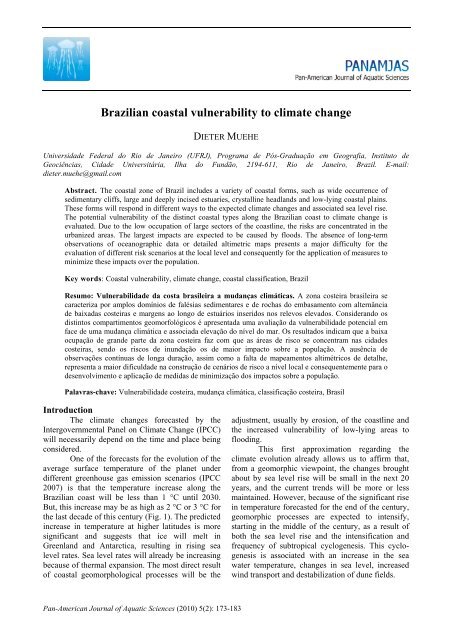Download full issue - PanamJAS
Download full issue - PanamJAS
Download full issue - PanamJAS
- No tags were found...
You also want an ePaper? Increase the reach of your titles
YUMPU automatically turns print PDFs into web optimized ePapers that Google loves.
Brazilian coastal vulnerability to climate changeDIETER MUEHEUniversidade Federal do Rio de Janeiro (UFRJ), Programa de Pós-Graduação em Geografia, Instituto deGeociências, Cidade Universitária, Ilha do Fundão, 2194-611, Rio de Janeiro, Brazil. E-mail:dieter.muehe@gmail.comAbstract. The coastal zone of Brazil includes a variety of coastal forms, such as wide occurrence ofsedimentary cliffs, large and deeply incised estuaries, crystalline headlands and low-lying coastal plains.These forms will respond in different ways to the expected climate changes and associated sea level rise.The potential vulnerability of the distinct coastal types along the Brazilian coast to climate change isevaluated. Due to the low occupation of large sectors of the coastline, the risks are concentrated in theurbanized areas. The largest impacts are expected to be caused by floods. The absence of long-termobservations of oceanographic data or detailed altimetric maps presents a major difficulty for theevaluation of different risk scenarios at the local level and consequently for the application of measures tominimize these impacts over the population.Key words: Coastal vulnerability, climate change, coastal classification, BrazilResumo: Vulnerabilidade da costa brasileira a mudanças climáticas. A zona costeira brasileira secaracteriza por amplos domínios de falésias sedimentares e de rochas do embasamento com alternânciade baixadas costeiras e margens ao longo de estuários inseridos nos relevos elevados. Considerando osdistintos compartimentos geomorfológicos é apresentada uma avaliação da vulnerabilidade potencial emface de uma mudança climática e associada elevação do nível do mar. Os resultados indicam que a baixaocupação de grande parte da zona costeira faz com que as áreas de risco se concentram nas cidadescosteiras, sendo os riscos de inundação os de maior impacto sobre a população. A ausência deobservações contínuas de longa duração, assim como a falta de mapeamentos altimétricos de detalhe,representa a maior dificuldade na construção de cenários de risco a nível local e consequentemente para odesenvolvimento e aplicação de medidas de minimização dos impactos sobre a população.Palavras-chave: Vulnerabilidade costeira, mudança climática, classificação costeira, BrasilIntroductionThe climate changes forecasted by theIntergovernmental Panel on Climate Change (IPCC)will necessarily depend on the time and place beingconsidered.One of the forecasts for the evolution of theaverage surface temperature of the planet underdifferent greenhouse gas emission scenarios (IPCC2007) is that the temperature increase along theBrazilian coast will be less than 1 °C until 2030.But, this increase may be as high as 2 °C or 3 °C forthe last decade of this century (Fig. 1). The predictedincrease in temperature at higher latitudes is moresignificant and suggests that ice will melt inGreenland and Antarctica, resulting in rising sealevel rates. Sea level rates will already be increasingbecause of thermal expansion. The most direct resultof coastal geomorphological processes will be theadjustment, usually by erosion, of the coastline andthe increased vulnerability of low-lying areas toflooding.This first approximation regarding theclimate evolution already allows us to affirm that,from a geomorphic viewpoint, the changes broughtabout by sea level rise will be small in the next 20years, and the current trends will be more or lessmaintained. However, because of the significant risein temperature forecasted for the end of the century,geomorphic processes are expected to intensify,starting in the middle of the century, as a result ofboth the sea level rise and the intensification andfrequency of subtropical cyclogenesis. This cyclogenesisis associated with an increase in the seawater temperature, changes in sea level, increasedwind transport and destabilization of dune fields.Pan-American Journal of Aquatic Sciences (2010) 5(2): 173-183
















